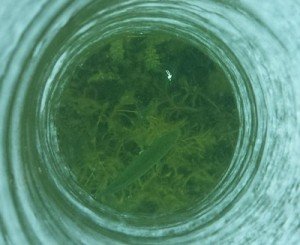 Sight fishing is nothing new to ice anglers. Sight fishing is a staring contest between you and the fish. Here we are, sitting above a hole cut in the ice staring at a wary bluegill, just waiting for it to take our tiny offering. This is as real as it gets. Everything is real time and what you see is what you get, there is no guessing. There is just something magical about actually watching a fish take your jig. “Now you see it, now you don’t.” You have to love that expression when sight fishing, because it’s so true. Panfish are notorious for inhaling and exhaling tiny morsels in a split second. Your helpless jig is now in the realm of the bluegill and its fate is entirely up to that plate sized trophy. You sit intently waiting for a reaction from the flutter below. You hold your breath when you see the fish move in and then suddenly you see a set of gills flare and the jig is gone. Set the hook! A tussle with a ‘bull’ bluegill never felt so good in your life. Now that’s sight fishing.
Sight fishing is nothing new to ice anglers. Sight fishing is a staring contest between you and the fish. Here we are, sitting above a hole cut in the ice staring at a wary bluegill, just waiting for it to take our tiny offering. This is as real as it gets. Everything is real time and what you see is what you get, there is no guessing. There is just something magical about actually watching a fish take your jig. “Now you see it, now you don’t.” You have to love that expression when sight fishing, because it’s so true. Panfish are notorious for inhaling and exhaling tiny morsels in a split second. Your helpless jig is now in the realm of the bluegill and its fate is entirely up to that plate sized trophy. You sit intently waiting for a reaction from the flutter below. You hold your breath when you see the fish move in and then suddenly you see a set of gills flare and the jig is gone. Set the hook! A tussle with a ‘bull’ bluegill never felt so good in your life. Now that’s sight fishing.
Locating sight fishing areas is rather effortless. I like to look for shallow green weeds and areas where you find panfish during the early spring. Panfish like to congregate in these shallow areas and their activity level skyrocket during these times. I personally like to call it the Late Ice Bonanza, because these panfish turn on the feedbags and become highly aggressive as the winter wears down. Once you find these spots, you’re going to want to punch a series holes over the immediate area. The reason I like to punch several holes is because when fishing shallow water the fish spook easily and if you decide to make small moves you don’t have to fire up the auger and scatter the school.
We spend much of the ice fishing season targeting fish in deeper water. We rely heavily on our flasher units to tell us whether or not there are fish below us and whether those fish are interested in our baits. We also drop down underwater cameras that allow us to partake in the underwater ecosystem. We’ve become accustomed to using artificial or technological means to determine what’s going on below the ice. Now, let’s give those machines a chance to cool off and use what we’ve had all along – our sense of sight.
Sight fishing is both productive and fun. You become a part of the underwater world and the underwater world becomes a part of you. Fish of all sizes and species use shallow water areas during late ice. Largemouth bass, northern pike, muskies, walleyes, perch and of course panfish, dwell in shallow water areas and will relate to the weeds at late ice. Now is the time to key in on the excellent fishing that the shallows can bring, and what better way is there then to embark on a day of sight fishing. You become as giddy as a school child when fish appear and every fish, no matter the size, gets your blood pumping.
Focusing intensely while a sunfish sniffs your bait only to watch a monster pike fly by at mach speed is no doubt a sight to behold, but that’s a common occurrence in the shallows during late ice. Watching a swine largemouth bass
inhale a gallon of water, along with your jig, will provide excitement enough for an angler of any level. Fishing is about fun and excitement, and sight fishing has a surplus of both.
So, position yourself over a hole and flip over the portable fish house and begin your journey. A portable fish house, like the Clam Fish Trap, is a must when sight fishing because you need to block out as much light as possible when trying to look down the hole. I close up all the windows of my portable to ensure the best results.
Sight fishing is a great way to get the kids hooked on the sport of ice fishing. A chance to actually see a fish swim by is exhilarating to any young angler. Now, add on the fact that the kid can actually watch the fish eat the bait and you just about guaranteed yourself an ice angler for life. So, enjoy the Late Ice Bonanza and try sight fishing if you haven’t already. The underwater world is waiting!
By Matt Johnson